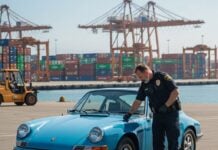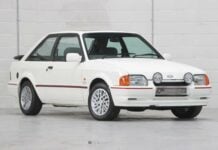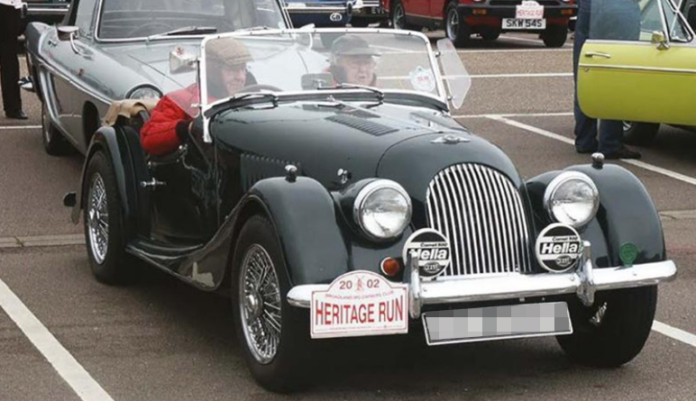Chris’ Mum and Dad were very proud owners of a 1968 Morgan Plus 4, which they bought as a more “modern” ride than their Austin 7. They enjoyed driving their Morgan, and toured extensively in the UK and Europe. After Chris’ Dad sadly passed away, the family decided it was time for the Morgan to begin a new chapter, making its biggest journey yet, across the Atlantic to join Chris and his family in Canada.
As always, Autoshippers were on hand from the beginning to make sure that everything went smoothly from end to end, so that this classic car can stay in the family, albeit thousands of miles from where this story began.
Shipping a Classic Car by Ro-Ro
Chris originally contacted Autoshippers back in 2019 when he was looking at buying a classic Mini from the UK and shipping it to Canada, at that time the planets didn’t align, but when Chris wanted to ship his Mum and Dads 1968 Morgan Plus 4 to Canada, he had no hesitation in contacting us again.
One reservation he had was – Should I Ship a Classic Car on a Ro-Ro Service?
Car Shipping Options from the UK to Canada
After the Autoshippers sales team were contacted by Chris, he was provided with a cost to ship his Morgan Plus 4 from the port of Southampton to Halifax in Canada using our Ro-Ro (Roll-on, Roll-off) service. This is usually the most cost-effective way of shipping a vehicle to Canada from the UK, and utilises specialist Ro-Ro vessels that allow vehicles of all shapes and sizes to be driven on and off via a ramp.
As Chris also had some spares to move along with his vehicle, as is often the case with Classic cars, he was also provided with the cost to ship via a dedicated 20-foot shipping container. This is the way that commercial freight is shipped worldwide and, as the vehicle is loaded in the UK and not taken out of the container until it has arrived at its destination, usually offers the most protection from the elements.
Comparing Car Shipping Options
Both Ro-Ro and Container shipping services have their own benefits.
Aside from the cost, Ro-Ro shipping is often quicker than container shipping, as the vehicles are delivered directly to the quayside meaning they can arrive only a day or so before the vessel is due to sail. This is replicated at the destination port and, once cleared and released by Customs, your vehicle can be collected directly from the quayside.
Container shipping is often used for expensive or rare vehicles. The vehicle is loaded and secured into its own dedicated 20-foot shipping container (or multiple vehicles into a 40-foot container) meaning it is not driven or open to the elements from then until it is unloaded at its destination. Often, other items can be transported in the vehicle if shipped via container shipping, whereas this is not permitted on the Ro-Ro service.
Ro-Ro vs Container Shipping
Due to the fact that a vehicle is driven on and off the Ro-Ro vessel, and secured on board without being containerised, it is often perceived that it is an unsafe way of shipping expensive or classic cars. As these are specialised vessels, and the vehicles are loaded by professional stevedores, the load design ensures maximum safety. There are lashing points throughout the lower decks of the vessel, which enable all of the vehicles to be secured in place and avoid movement during transport across the ocean.
Vehicle manufacturers worldwide use Ro-Ro to transport new cars from country to country, and they wouldn’t do so if damages were likely.
As well as the port-to-port shipping costs, there are other costs that are incurred during the transportation of vehicles overseas. Often, although the port-to-port shipping costs are similar, container shipping destination costs, such as terminal handling and inland transportation costs, mean that the total cost is much higher than for Ro-Ro. Autoshippers offer a fully transparent quotation, and are able to advise you of all costs for either all shipping options.
Shipping a 1968 Morgan to Halifax, Canada via Ro-Ro
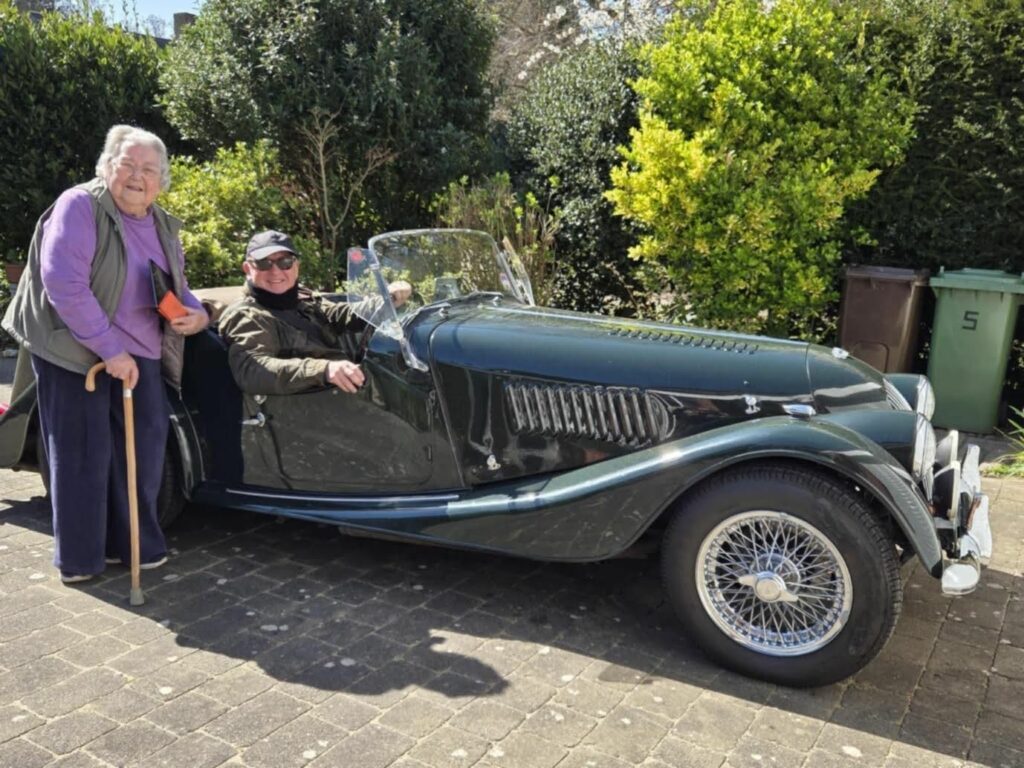

Back to Chris, who weighed up all of this options and decided to book his 1968 Morgan Plus 4 to be shipped to Canada on Autoshippers’ Ro-Ro Service. Now it was over to us to make sure that the process was as seamless as possible by offering assistance every step of the way.
Getting the Documents in Order
As with all vehicle shipping, from Classic cars to Motorbikes and everything in between, the key to a seamless process begins with the paperwork. Autoshippers have been shipping vehicles to Canada for our customers for over 25 years, so we know a thing or two about the requirements. For example, Canada has strict rules that require all imported vehicles under 15-years old to comply with current Canadian Motor Vehicle Safety Standards (CMVSS), so this is the first thing we bring to the attention of our customers. Obviously, this does not affect this Classic vehicle which was manufactured almost 60 years ago.
Documents Required for Shipping Vehicles to Canada
The way to check whether an imported vehicle can be shipped in to Canada, is to check the manufactured date on the V5. This is one of the documents that is a requirement for shipping a vehicle to Canada;
- V5 Vehicle Registration Document: This is to prove ownership and, in some cases such as shipping to Canada or the USA, to verify the vehicles manufactured date and confirm its exemption status.
- Bill of Sale or Purchase Invoice: If the V5 isn’t in your name, you will need to have a bill of sale or purchase invoice from the registered owner of the vehicle shown in the V5, to you. This proves ownership has changed hands.
As Chris had been gifted the Morgan by his parents, the V5 had been amended and was in his name.
Transport from Door to Southampton Quay, Including a Detour!
Although Autoshippers can offer a specialist vehicle collection service nationwide, Chris chose to drive the Morgan to the quayside himself, and he made the final drive on UK soil a memorable one. Chris, in the spirit of classic motoring, took the car to the Goodwood Members Meeting on his way to Southampton port, adding a touch of nostalgia before the big Atlantic Crossing.


After this short detour, Chris then drove to the quayside at Southampton port. Armed with the Standard Shipping Note, which Autoshippers had provided and is handed in on delivery with all booking details on it, this magical Morgan was then loaded onto the Ro-Ro vessel by specially trained operatives, and secured below deck safely to avoid any movement during the sea voyage.
Onboard the Ro-Ro Vessel and Across the Atlantic
Chris’ Morgan was driven onto the vessel Tannhauser, which is around 200m in length and capable of carrying around 8,000 vehicles within her 13 decks. Sailing out of Southampton and directly to the Port of Halifax, Nova Scotia in Canada, the port-to-port transit was just 10days.
Halifax port is a primary entry point for vehicles into Canada, and handles around 250,000 vehicles annually at the specialised vehicle processing facility, known as the Autoport. The port also has the ability to handle containerised shipping, and has two container terminals, and has becoming an increasingly popular port for cruise ships, welcoming over 300,000 passengers per year.
Once the Tannhauser docked in the very busy port of Halifax, local port agents carefully drove the Morgan off the vessel, and onto Canadian soil for the very first time. The next stage of the journey was the clearance through Canadian Customs.
What to Expect on Arrival in Canada


Navigating Canadian Customs and the CBSA
The Canada Border Services Agency (CBSA) is responsible for all vehicles entering the country, and their process can be quite rigorous. This is where the preparation Chris completed with Autoshippers pays off. Because we correctly identified the 1968 Morgan as a vehicle exempt under the 15-Year Rule, the process moved quickly.
The CBSA officer on duty examined the following:
- Proof of Age and Ownership: Chris’s V5 document, confirming the 1968 date of manufacture. This immediately confirms its exemption from the complex safety and emission standards required for modern vehicles.
- Bill of Lading: These documents confirm the details of the shipment itself.
- Cleanliness Inspection: Vehicles arriving in Canada may be subject to a biosecurity inspection to ensure they are free of foreign soil, pests, or plant matter. This is why Autoshippers always stresses the importance of cleaning the vehicle before it is delivered to the UK port. A clean car can avoid mandatory, expensive cleaning fees and significant delays at the Canadian border.
Upon successful review, the officer processed the import. Chris was required to pay the applicable Goods and Services Tax (GST), which is calculated based on the declared value of the vehicle plus any applicable duties. For vehicles manufactured outside of North America, an import duty may also apply. Once these fees are paid, the Morgan is officially released from CBSA control.
The Transporter Delivery to Ontario
With the official import stamps secured and the customs formalities complete, the Morgan was ready for the last part of its epic journey. While Ro-Ro shipping gets the car to the port, we know that for a cherished classic like this, the final delivery needs just as much care.
Chris opted for delivery on a transportation service, rather than making the 3,000-mile journey to Ontario himself. This meant that instead of driving the Morgan away from the busy port terminal, an experienced local Canadian car transporter was arranged. The covered transporter carefully loaded and secured the Morgan, minimizing any unnecessary road risk after its long voyage.
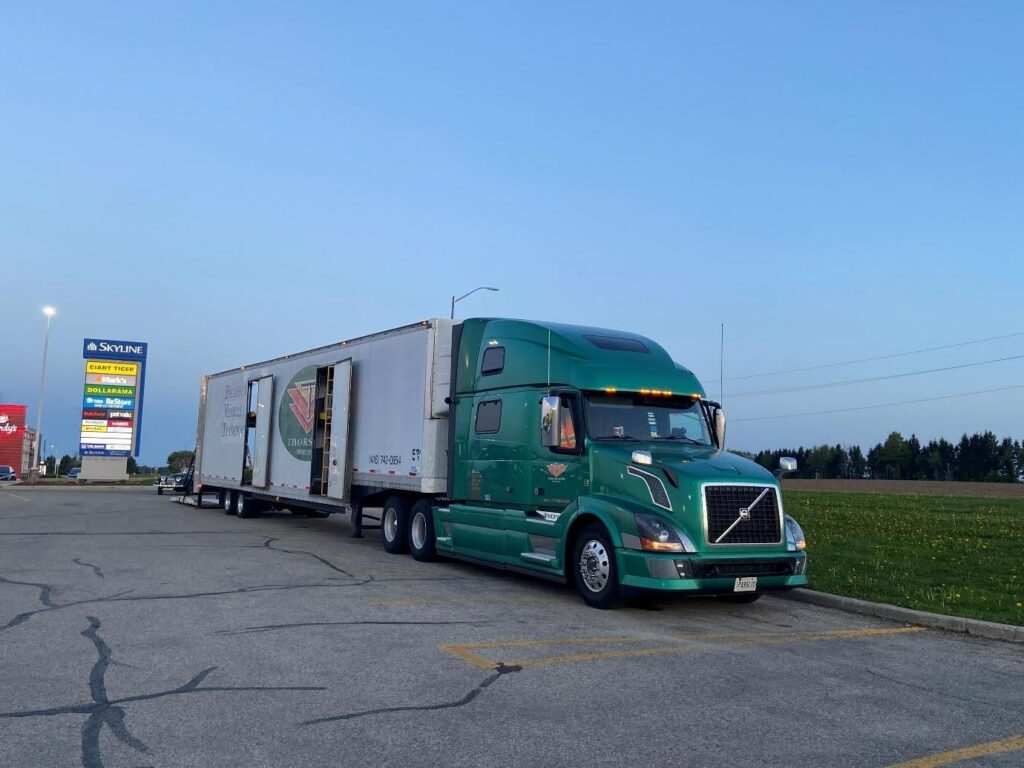

Although this was the final stage of delivery, when Chris was reunited with his prized 1968 Morgan, there were a few more hoops to jump through.
Provincial Registration and Final Steps
To legally drive the car on Canadian roads, it needed to be registered in the destination province. Because the Morgan is an exempt classic, it did not need to go through the Registrar of Imported Vehicles (RIV) program. However, it still needed to meet basic provincial requirements:
- Provincial Safety Inspection: The Morgan was required to pass a provincial safety inspection, ensuring components like brakes, lights, and tyres were roadworthy.
- Insurance and Licensing: Chris would then take his customs release documents and the successful inspection certificate to the local licensing office to purchase insurance and register the car, finally receiving its new Canadian number plates.
Once the new plates were affixed, this family heirloom—a symbol of so many memories—was officially ready for the open roads of Canada, concluding its biggest and most important journey yet.


A Legacy of Craftsmanship: The 1968 Morgan Plus 4
The story of this classic car’s journey is inseparable from the unique legacy of the Morgan Motor Company itself—a blend of Edwardian engineering and timeless British design.
The Morgan Motor Company Heritage
Founded in 1909 by Henry Frederick Stanley Morgan (H.F.S. Morgan) in Malvern, Worcestershire, the company is one of the oldest and most distinctive British sports car manufacturers.
Morgan’s cars are famous for their refusal to chase fads. They retain a construction method that dates back to the 1930s, using:
- Ash Wood: The bodywork is framed over a traditional ash wood structure, prized for its flexibility and lightness.
- Steel Chassis: The main structure is a durable steel ladder chassis.
- Sliding Pillar Suspension: The famous independent front suspension system uses vertical sliding pillars, a design H.F.S. Morgan patented in 1909. This unique setup gives the car its characteristic feel and handling.
The 1968 Morgan Plus 4
The Plus 4 was introduced in 1950 as a more powerful option, and the 1968 model represents one of the final production years for this popular generation. At its heart, the 1968 Plus 4 was powered by a proven Triumph TR4 straight-four engine. This 2138 cc unit, which was also found in the contemporary Triumph sports car, was rated to produce around 105 bhp at 4,750 rpm.
This power output, combined with the car’s famously low weight (typically under 850 kg or 1,875 lbs), ensured a sprightly performance, allowing the two-seater roadster to reach a top speed of around 100 mph and accelerate from 0-60 mph in under 10 seconds—a solid performance for the era.
This blend of historical construction with proven, robust mechanicals is why the Morgan Plus 4 remains a cherished classic, perfectly suited for the scenic Canadian roads that now await it.
Autoshippers – Experts in Classic Car Shipping
Our Commitment to Your Classic Car
At Autoshippers, we don’t just ship cars, we relocate irreplaceable pieces of automotive and family history. Our reputation is built on over 25 years of dedicated service, and we are specialists in the requirements of Classic, Vintage and Collector Vehicle shipping.
When you entrust a vehicle to us, just like Chris and his 1968 Morgan Plus 4, passed down from his mum and dad after years of joyous driving, you are choosing a shipping company who understands that this is more than just cargo, this is a priceless, family heirloom.
Contact Autoshippers for Information and Costs
If you need proof of our commitment, get in touch with our dedicated, knowledgeable team, who are passionate about shipping vehicles. They love to hear the stories behind your vehicle, whether you are moving overseas and taking your family car with you, or buying a vintage motorbike from a dealer in the UK for fun on the roads of your home country.
Give us a call on +441179828123 / 0800 389 0784, or send us an email on sales@autoshippers.co.uk and we will get back to you immediately. You can also head over to our website, where we have details on Customs procedures for import into many countries, links to the relevant sites for registration details, pictures of recent cars that we have shipped and our quotation form, where you can send us details of your vehicle and we can provide a cost to ship.
We are waiting for your contact and are happy to help.




